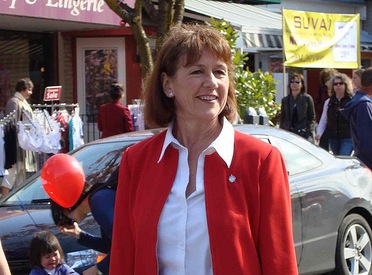If you want to see the Harper Conservatives defeated in 2015 – or at least reduced to a minority government — it’s time you started paying attention to what Joyce Murray is saying.
Murray is a Liberal leadership candidate from B.C., and the only candidate promising one-time co-operation with both the NDP and Greens to defeat Conservative candidates in a number of key ridings in the next election.
Murray, who has been a federal MP for five years and earlier a Liberal Cabinet Minister in B.C., also supports proportional representation (PR) — a method of electing Members of Parliament that would abolish the archaic first-past-the-post system that allowed Harper to win a majority in 2011 with only 39 per cent of the popular vote.
Because of the way the Liberals have chosen to run their leadership race, any Canadian old enough to vote and not a member of another party can help Murray win the leadership.
Based on the money she has raised and the number of prominent Liberals who have endorsed her, Joyce Murray is somewhere in the middle of the pack of seven candidates.
True, it’s a longshot that she could win, but if thousands of people who want party co-operation and PR get behind Murray, it could happen. There is an opening.
Under the new bizarre way the Liberals are organizing the contest, there will be no party convention. It’s all being conducted over the Internet or by telephone.
In an effort to reach out and expand their base, the Liberals have created a new voter category called “supporter.” Oddly, a supporter does not need to pay money or become a party member to vote.
You and your friends can easily become Murray supporters and have no further obligations to the Liberal Party.
Interestingly, each riding across the country has equal weight when it comes to counting votes. A riding with only 100 members and “supporters” has the same amount of influence as a riding with a total of, say, 5,000.
While a support-Murray campaign has been quietly under way in some parts of the country, there’s not much time left to vote for her. Supporters and new members must identify themselves by March 3. You can vote by filling out this page.
The new Liberal leader will be selected between April 7 and 14 over the Internet and by telephone using a ranked ballot.
The popular view is that Justin Trudeau will run away with the leadership. But it’s possible that a lot of Justin’s public popularity is based on the Trudeaumania he has created among mostly young people. However, his public appeal may not translate into votes. Moreover, many ‘conservative’ Liberals are not keen on having a ‘loose cannon’ like Trudeau take over the party. In addition, they worry that, if Trudeau wins, the Harper attack dogs will quickly tear him apart.
Several groups support the idea of parties working together to defeat the Conservatives; among them are LeadNow’s Cooperate for Canada project, Project Democracy, Catch 22 Harper Conservatives, and new groups in many communities, including Kitchener-Waterloo, Peterborough, Toronto and Salt Spring Island.
Murray’s presence in federal politics is also important because of her support for proportional representation, an idea endorsed by the NDP but shunned by other Liberal candidates and the Conservatives. Born in South Africa, she is unique in that she is in favour of the legalization of marijuana. She and her husband own a tree planting company that operates in several countries and she has a degree from the Executive Master’s program for Business Administration, focused on the environmental sustainability from Simon Fraser University.
Earlier this week Green Party leader Elizabeth May — who is a strong supporter of party co-operation — praised Murray, stopping just short of endorsing her campaign. May said some Greens are asking her advice on whether to get involved in helping Murray, and she doesn’t explicitly try to dissuade them.
Helping Murray is also on the minds of a lot of NDP members. “I believe most groups are approaching it as an individual decision,” said an executive member of one NDP group, “but there has been a lot of push to join the Liberals to move this forward.”
If the Liberals and Greens alone had co-operated by not running candidates against each other in several key ridings in 2011, The Canadian Press calculated that they would have picked up an additional 12 seats or more, not defeating the Conservatives but likely reducing them to minority government status.
If all three parties were to agree on some system whereby only one party would run a candidate is a number of select ridings, enough Canadians would probably support the one-time effort to trounce the Conservatives.
NDP Leader Tom Mulcair rejects any sort of electoral co-operation with the Liberals or Greens, hoping the party can turn its role as Opposition into a win in 2015. Both Murray and May hope he changes his mind.
At this stage, with the election two years away, the NDP’s chances of winning don’t appear particularly strong. Under Mulcair’s leadership, the party hasn’t exactly excited Canadians. Even with all of the terrible things the Conservatives have done, they still stand at 34.3 per cent in the latest opinion poll. The Liberals are second at 27.6 and the NDP third at 27.1 per cent.
If Tom Mulcair can conceive of caring more about his country than his political party, then perhaps he should start listening to what Joyce Murray is saying.
Nick Fillmore is a Toronto freelance journalist and social activist who worked in the mainstream media for more than 25 years. He also was one of the organizers of Catch 22 Harper Conservatives. Feedback welcomed at: fillmore0274[at]rogers[dot]com




